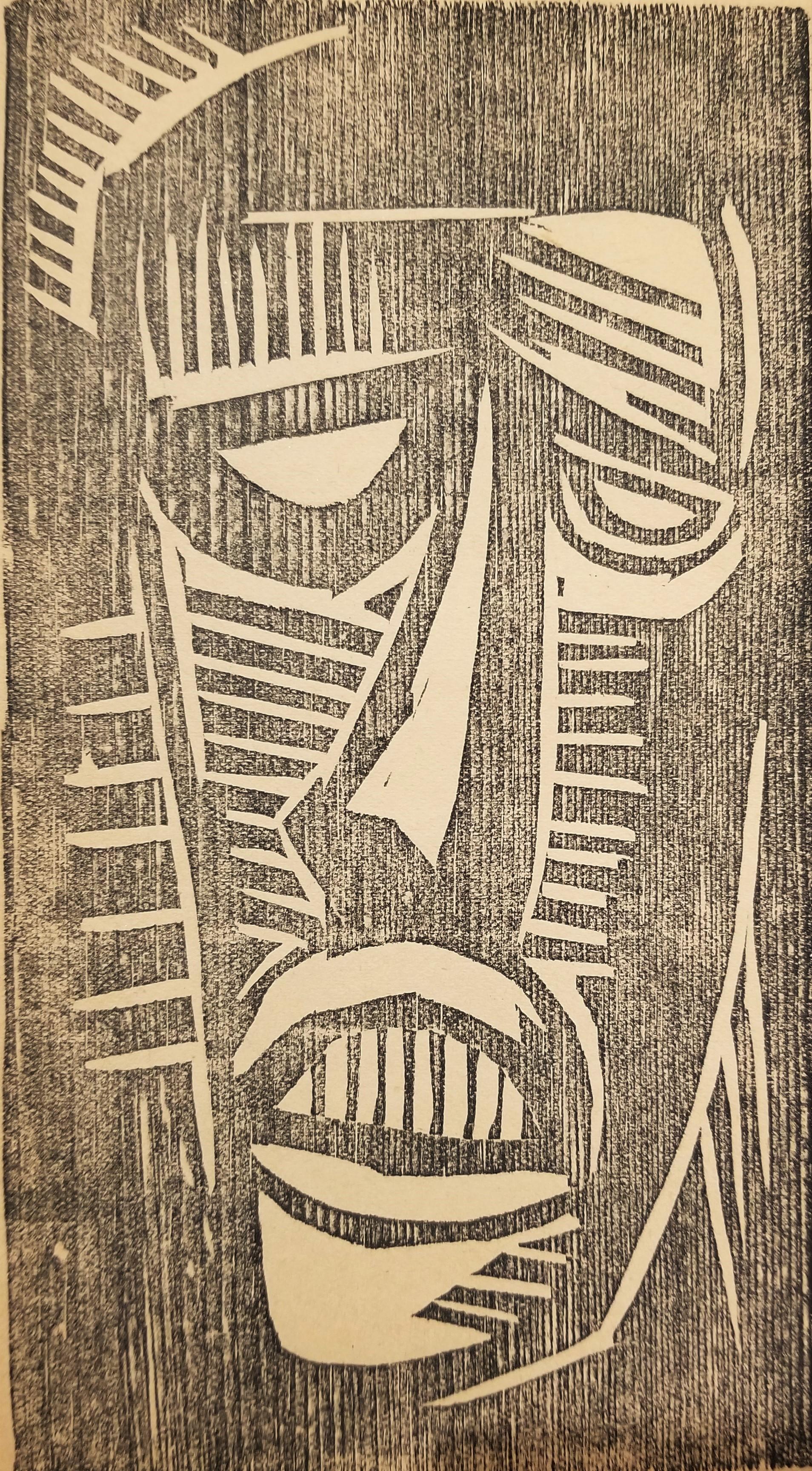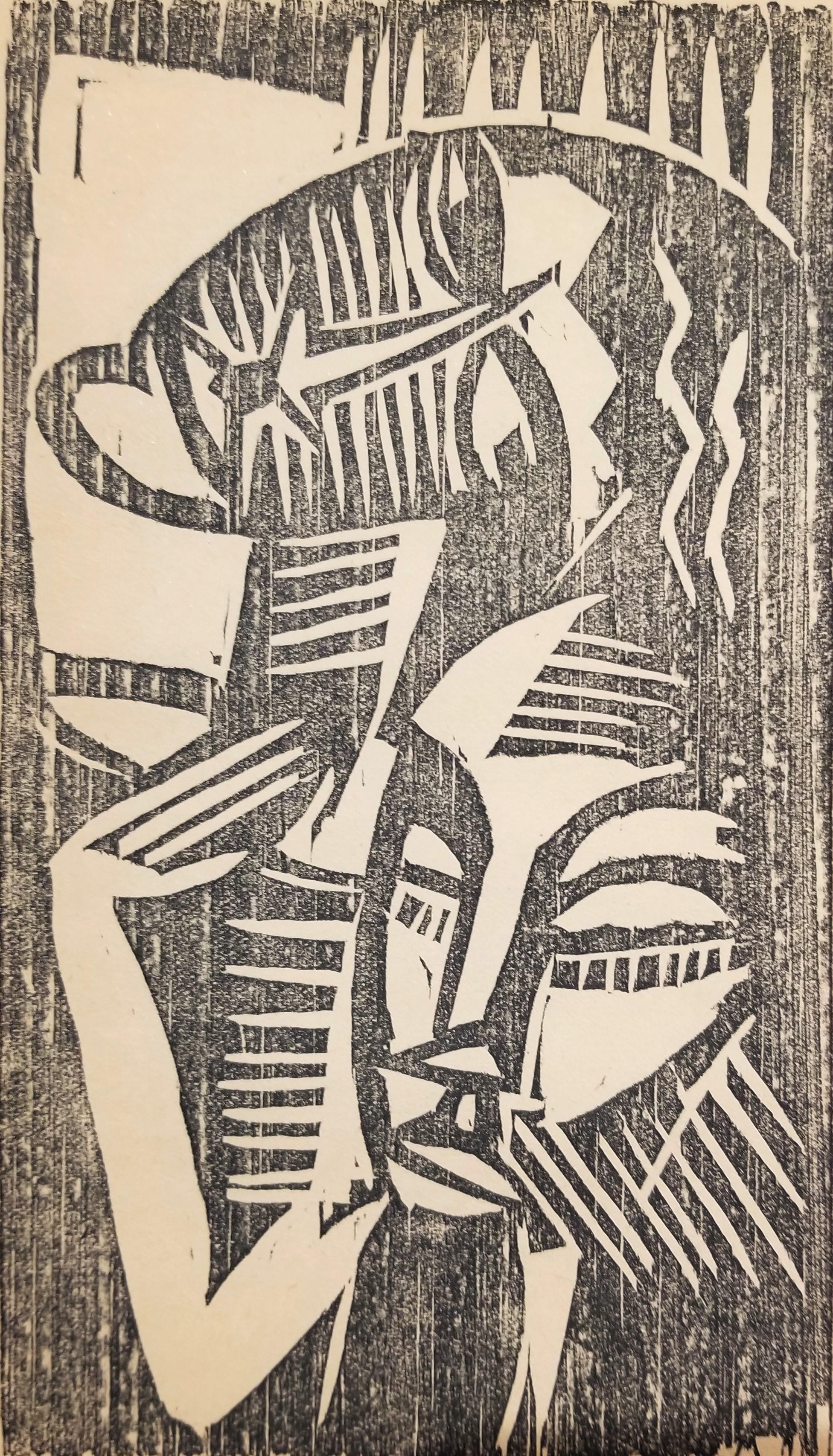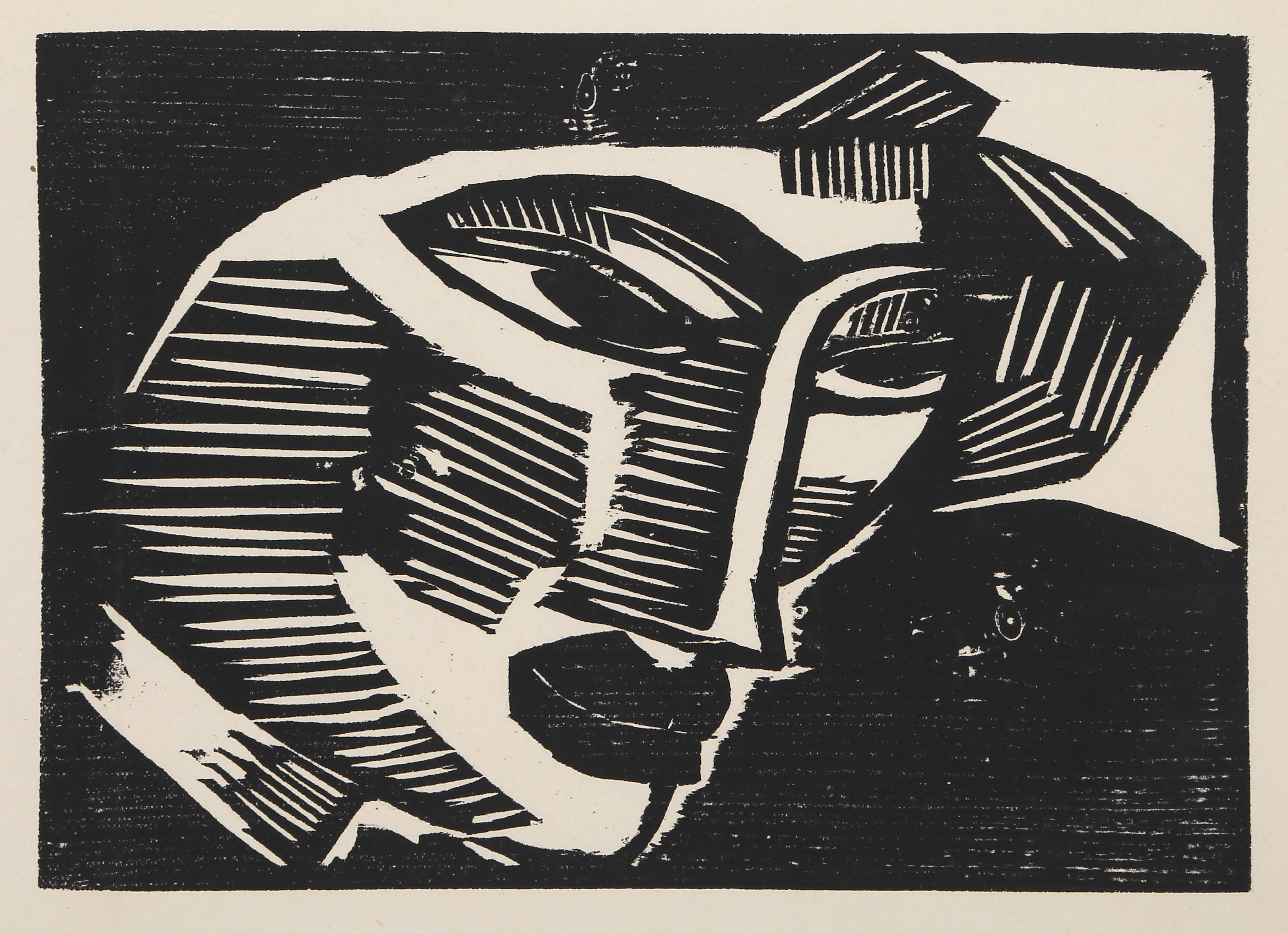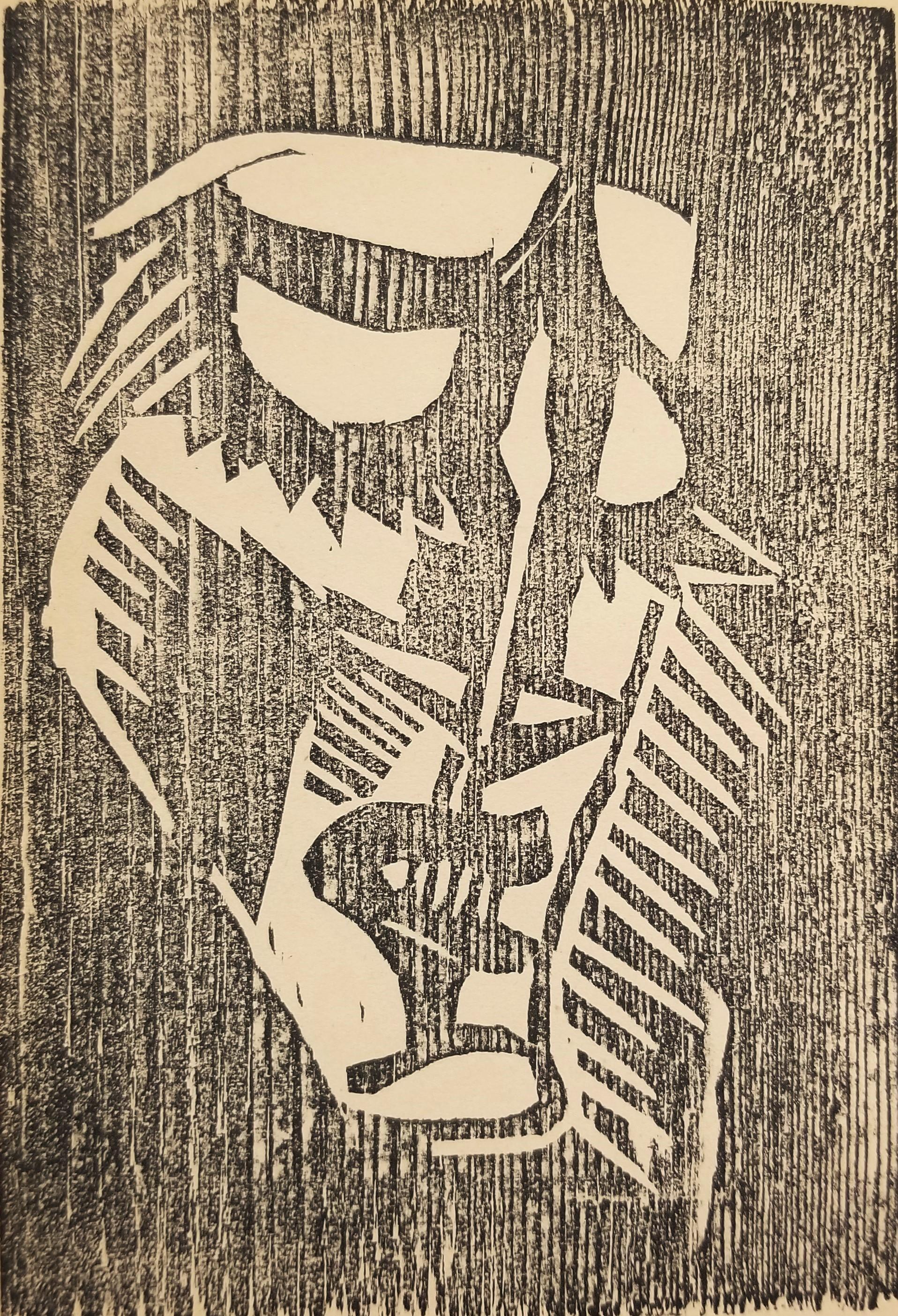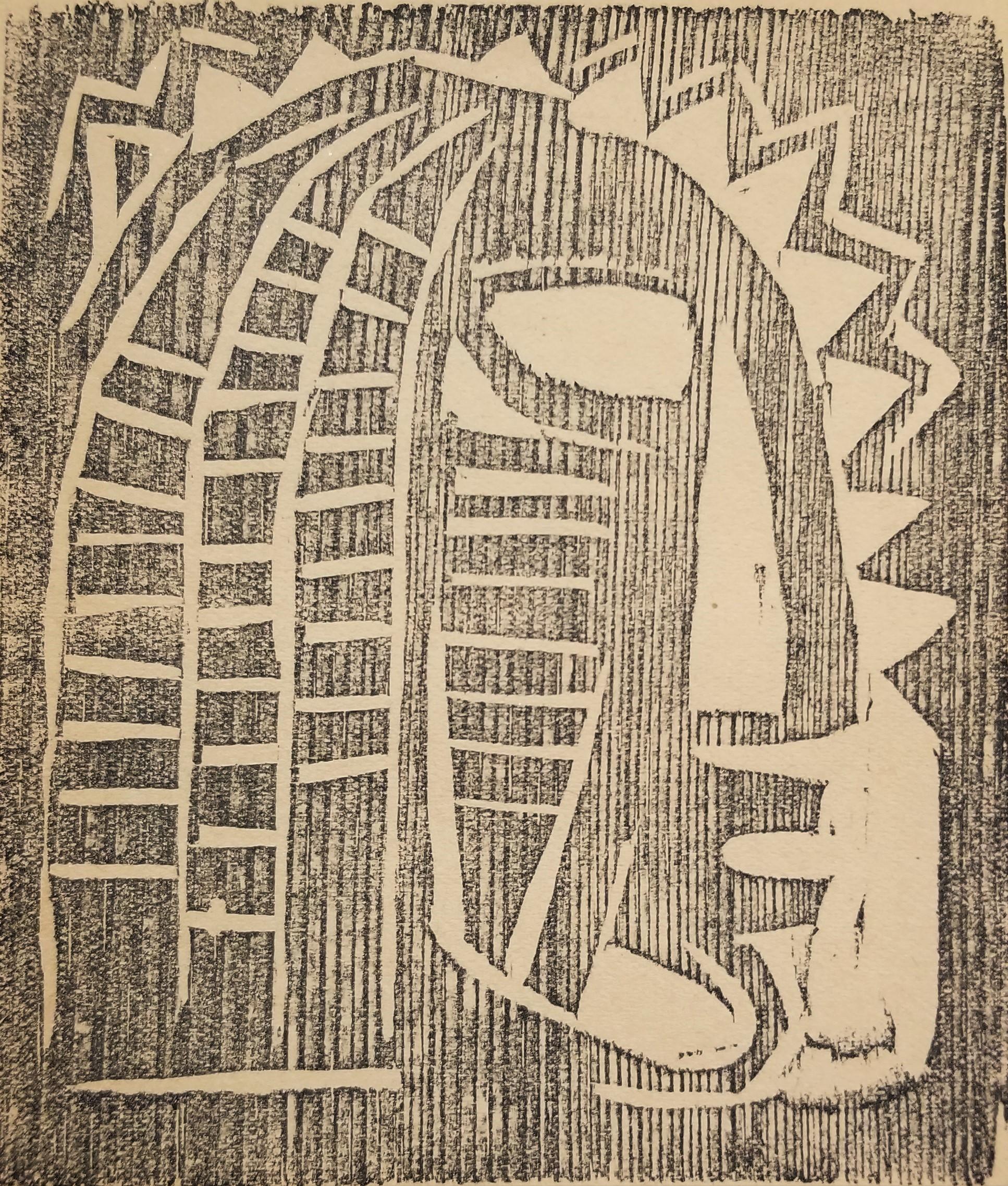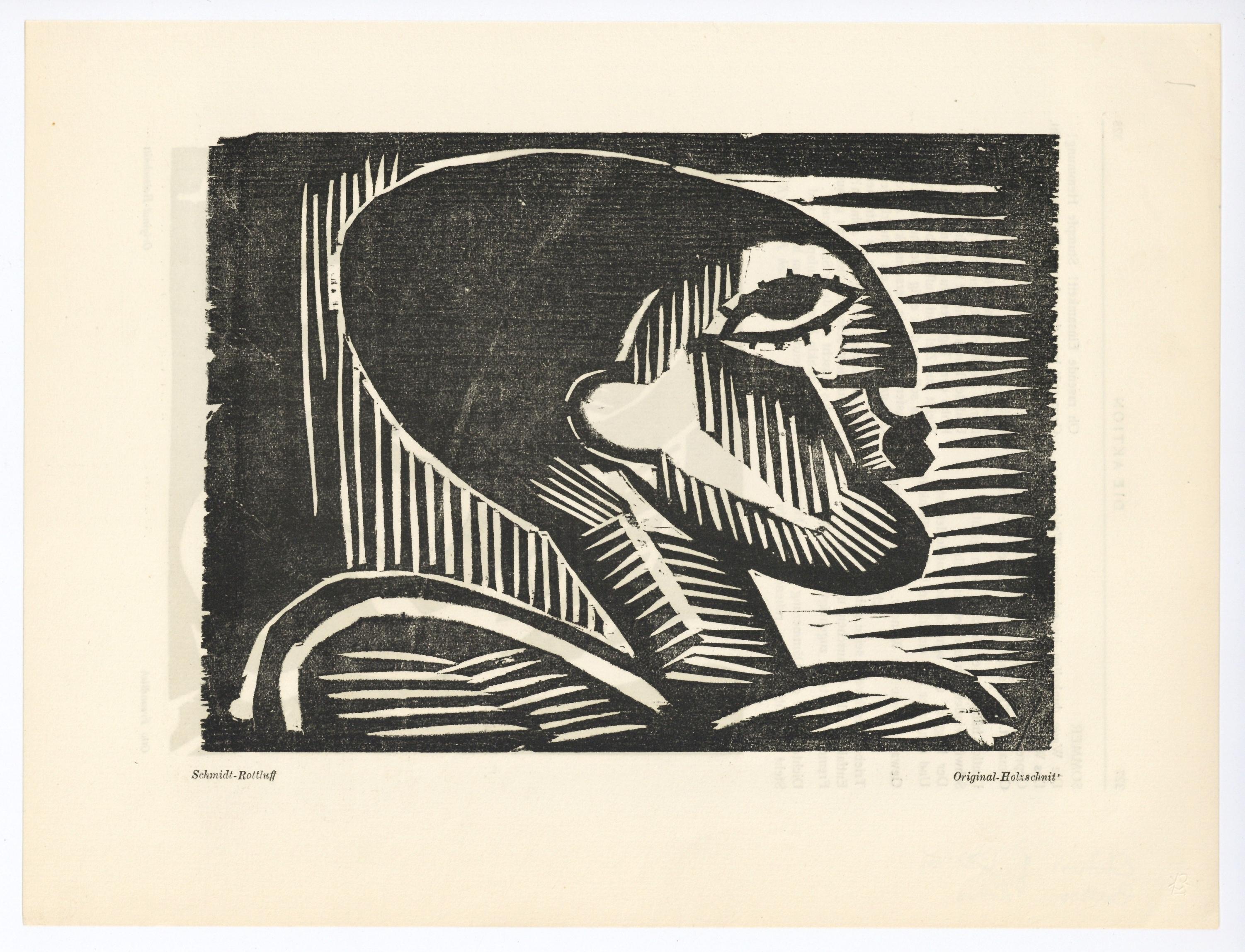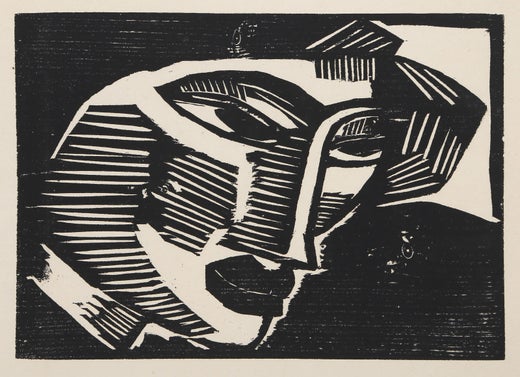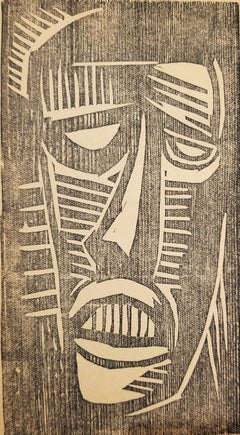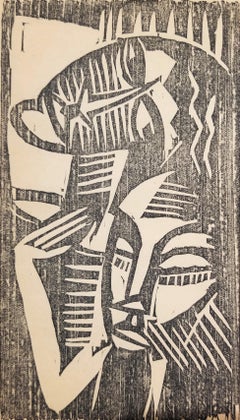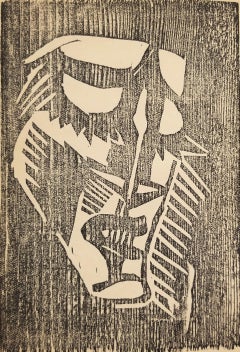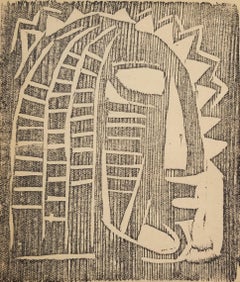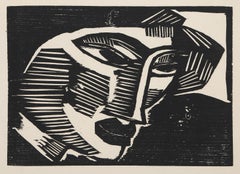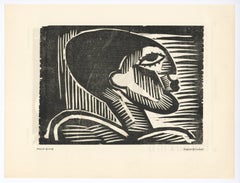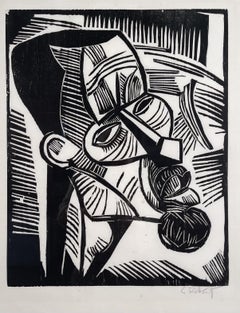Items Similar to Weiblicher Kopf (Female Head) /// German Expressionism Rottluff Woodcut Modern
Want more images or videos?
Request additional images or videos from the seller
1 of 8
Karl Schmidt-RottluffWeiblicher Kopf (Female Head) /// German Expressionism Rottluff Woodcut Modern1918
1918
$350
£263.17
€305.61
CA$488.77
A$542.08
CHF 284.67
MX$6,657.12
NOK 3,603.70
SEK 3,398.33
DKK 2,280.16
Shipping
Retrieving quote...The 1stDibs Promise:
Authenticity Guarantee,
Money-Back Guarantee,
24-Hour Cancellation
About the Item
Artist: Karl Schmidt-Rottluff (German, 1884-1976)
Title: "Weiblicher Kopf (Female Head)"
Portfolio: Das Spiel Christa vom Schmerz der Schönheit des Weibes (The Play Christa from the Pain of the Beauty of the Woman)
*Issued unsigned
Year: 1918
Medium: Original Woodcut Engraving on wove paper
Limited edition: Unknown
Printer: Fritz Voigt, Berlin, Germany
Publisher: Verlag Die Aktion, Berlin, Germany
Reference: Schapire No. 224, page 46; Jentsch No. 35. Rifkind No. 2563; Lang No. 300; Reed No. 118
Overall size with attached page: 8.5" x 10.63"
Sheet size: 8.5" x 5.38"
Image size: 4.88" x 3.5"
Condition: Toning to sheet (as normal). In very good condition
Very rare
Notes:
Provenance: private collection - Oxnard, CA. Comes from a complete originally bound 48 page folio with 9 original woodcut engravings by Schmidt-Rottluff. Text by Alfred Brust. Presently attached to its accompanying page. The cover and title pages in pictures are not included, only for reference/provenance. There is an example of this work in the permanent collection of the Brücke Museum, Berlin, Germany.
Biography:
Karl Schmidt-Rottluff (born December 1, 1884, Rottluff, near Chemnitz, Germany—died August 9, 1976, West Berlin [now Berlin]), German painter and printmaker who was noted for his Expressionist landscapes and nudes.
In 1905 Schmidt-Rottluff began to study architecture in Dresden, Germany, where he and his friend Erich Heckel met Ernst Ludwig Kirchner and Fritz Bleyl, two other architecture students who shared their passion for painting. Together they formed the organization of Expressionist artists known as Die Brücke (“The Bridge”), united by the goal of creating a modern, intensely emotional style.
The artists of Die Brücke typically preferred to portray scenes of urban life, but Schmidt-Rottluff is particularly known for his rural landscapes. He initially painted in an Impressionist style, but his painting Windy Day (1907) shows the artist’s transition to his mature style, which is characterized by flat areas of boldly dissonant colours. A representative example of this mature work is Self-Portrait with Monocle (1910). Like the other Brücke artists, Schmidt-Rottluff had also begun to explore the expressive potential of the woodcut medium. In 1911 Schmidt-Rottluff, with his fellow Die Brücke members, moved to Berlin, where he painted works with more angular, geometric forms and distorted space, revealing his new interest in Cubism and African sculpture.
After World War I Schmidt-Rottluff became increasingly interested in religious themes, as seen in the woodcut Head of Christ (1918), which is one of a series of prints about the life of Christ. During the 1920s Schmidt-Rottluff’s work became more subdued and harmonious, losing much of its former vigour and integrity. When the Nazis gained power in Germany, he was forbidden to paint. After World War II he taught art and resumed painting, although he never regained the power of his early works.
- Creator:Karl Schmidt-Rottluff (1884-1976, German)
- Creation Year:1918
- Dimensions:Height: 8.5 in (21.59 cm)Width: 5.38 in (13.67 cm)
- Medium:
- Movement & Style:
- Period:
- Condition:(Very Good).
- Gallery Location:Saint Augustine, FL
- Reference Number:1stDibs: LU121212327062
Karl Schmidt-Rottluff
Karl Schmidt-Rottluff (born December 1, 1884, Rottluff, near Chemnitz, Germany—died August 9, 1976, West Berlin [now Berlin]), German painter and printmaker who was noted for his Expressionist landscapes and nudes. In 1905 Schmidt-Rottluff began to study architecture in Dresden, Germany, where he and his friend Erich Heckel met Ernst Ludwig Kirchner and Fritz Bleyl, two other architecture students who shared their passion for painting. Together they formed the organization of Expressionist artists known as Die Brücke (“The Bridge”), united by the goal of creating a modern, intensely emotional style. The artists of Die Brücke typically preferred to portray scenes of urban life, but Schmidt-Rottluff is particularly known for his rural landscapes. He initially painted in an Impressionist style, but his painting Windy Day (1907) shows the artist’s transition to his mature style, which is characterized by flat areas of boldly dissonant colours. A representative example of this mature work is Self-Portrait with Monocle (1910). Like the other Brücke artists, Schmidt-Rottluff had also begun to explore the expressive potential of the woodcut medium. In 1911 Schmidt-Rottluff, with his fellow Die Brücke members, moved to Berlin, where he painted works with more angular, geometric forms and distorted space, revealing his new interest in Cubism and African sculpture. After World War I Schmidt-Rottluff became increasingly interested in religious themes, as seen in the woodcut Head of Christ (1918), which is one of a series of prints about the life of Christ. During the 1920s Schmidt-Rottluff’s work became more subdued and harmonious, losing much of its former vigour and integrity. When the Nazis gained power in Germany, he was forbidden to paint. After World War II he taught art and resumed painting, although he never regained the power of his early works.
About the Seller
5.0
Platinum Seller
Premium sellers with a 4.7+ rating and 24-hour response times
Established in 1978
1stDibs seller since 2015
1,326 sales on 1stDibs
Typical response time: <1 hour
- ShippingRetrieving quote...Shipping from: Saint Augustine, FL
- Return Policy
Authenticity Guarantee
In the unlikely event there’s an issue with an item’s authenticity, contact us within 1 year for a full refund. DetailsMoney-Back Guarantee
If your item is not as described, is damaged in transit, or does not arrive, contact us within 7 days for a full refund. Details24-Hour Cancellation
You have a 24-hour grace period in which to reconsider your purchase, with no questions asked.Vetted Professional Sellers
Our world-class sellers must adhere to strict standards for service and quality, maintaining the integrity of our listings.Price-Match Guarantee
If you find that a seller listed the same item for a lower price elsewhere, we’ll match it.Trusted Global Delivery
Our best-in-class carrier network provides specialized shipping options worldwide, including custom delivery.More From This Seller
View AllMännlicher Kopf von vorn (Male Head from the Front) /// German Expressionism
By Karl Schmidt-Rottluff
Located in Saint Augustine, FL
Artist: Karl Schmidt-Rottluff (German, 1884-1976)
Title: "Männlicher Kopf von vorn (Male Head from the Front)"
Portfolio: Das Spiel Christa vom Schmerz der Schönheit des Weibes (The Play Christa from the Pain of the Beauty of the Woman)
*Issued unsigned
Year: 1918
Medium: Original Woodcut Engraving on wove paper
Limited edition: Unknown
Printer: Fritz Voigt, Berlin, Germany
Publisher: Verlag Die Aktion, Berlin, Germany
Reference: Schapire No. 226, page 46; Jentsch No. 35. Rifkind No. 2563; Lang No. 300; Reed No. 118
Overall size with attached page: 8.5" x 10.63"
Sheet size: 8.5" x 5.38"
Image size: 6.38" x 3.5"
Condition: Toning to sheet (as normal). In very good condition
Very rare
Notes:
Provenance: private collection - Oxnard, CA. Comes from a complete originally bound 48 page folio with 9 original woodcut engravings by Schmidt-Rottluff. Text by Alfred Brust. Presently attached to its accompanying page. The cover and title pages in pictures are not included, only for reference/provenance. There is an example of this work in the permanent collection of the Brücke Museum, Berlin, Germany.
Biography:
Karl Schmidt-Rottluff (born December 1, 1884, Rottluff, near Chemnitz, Germany—died...
Category
1910s Expressionist Portrait Prints
Materials
Engraving, Woodcut
Männlicher Kopf an weibliche (Male Head Leaning against Female) /// Rottluff
By Karl Schmidt-Rottluff
Located in Saint Augustine, FL
Artist: Karl Schmidt-Rottluff (German, 1884-1976)
Title: "Männlicher Kopf an weibliche (Male Head Leaning against Female)"
Portfolio: Das Spiel Christa vom Schmerz der Schönheit des Weibes (The Play Christa from the Pain of the Beauty of the Woman)
*Issued unsigned
Year: 1918
Medium: Original Woodcut Engraving on wove paper
Limited edition: Unknown
Printer: Fritz Voigt, Berlin, Germany
Publisher: Verlag Die Aktion, Berlin, Germany
Reference: Schapire No. 225, page 46; Jentsch No. 35. Rifkind No. 2563; Lang No. 300; Reed No. 118
Sheet size: 8.5" x 5.38"
Image size: 6.25" x 3.57"
Condition: Toning to sheet (as normal). In very good condition
Very rare
Notes:
Provenance: private collection - Oxnard, CA. Comes from a complete originally bound 48 page folio with 9 original woodcut engravings by Schmidt-Rottluff. Text by Alfred Brust. The cover and title pages in pictures are not included, only for reference/provenance. There is an example of this work in the permanent collection of the Brücke Museum, Berlin, Germany.
Biography:
Karl Schmidt-Rottluff (born December 1, 1884, Rottluff, near Chemnitz, Germany—died...
Category
1910s Expressionist Figurative Prints
Materials
Engraving, Woodcut
Männlicher Kopf von vorn, nach rechts gewandt (Male Head Facing Right)
By Karl Schmidt-Rottluff
Located in Saint Augustine, FL
Artist: Karl Schmidt-Rottluff (German, 1884-1976)
Title: "Männlicher Kopf von vorn, nach rechts gewandt (Male Head Facing Right)"
Portfolio: Das Spiel Christa vom Schmerz der Schönhe...
Category
1910s Expressionist Portrait Prints
Materials
Engraving, Woodcut
Männlicher Kopf im Profil (Male Head in Profile) /// German Expressionism Modern
By Karl Schmidt-Rottluff
Located in Saint Augustine, FL
Artist: Karl Schmidt-Rottluff (German, 1884-1976)
Title: "Männlicher Kopf im Profil (Male Head in Profile)"
Portfolio: Das Spiel Christa vom Schmerz der Schönheit des Weibes (The Play Christa from the Pain of the Beauty of the Woman)
*Issued unsigned
Year: 1918
Medium: Original Woodcut Engraving on wove paper
Limited edition: Unknown
Printer: Fritz Voigt, Berlin, Germany
Publisher: Verlag Die Aktion, Berlin, Germany
Reference: Schapire No. 219, page 45; Jentsch No. 35. Rifkind No. 2563; Lang No. 300; Reed No. 118
Overall size with attached page: 8.5" x 10.63"
Sheet size: 8.5" x 5.38"
Image size: 4" x 3.38"
Condition: Toning to sheet (as normal). In very good condition
Very rare
Notes:
Provenance: private collection - Oxnard, CA. Comes from a complete originally bound 48 page folio with 9 original woodcut engravings by Schmidt-Rottluff. Text by Alfred Brust. Presently attached to its accompanying page. The cover and title pages in pictures are not included, only for reference/provenance. There is an example of this work in the permanent collection of the Brücke Museum, Berlin, Germany.
Biography:
Karl Schmidt-Rottluff (born December 1, 1884, Rottluff, near Chemnitz, Germany—died...
Category
1910s Expressionist Portrait Prints
Materials
Engraving, Woodcut
Stehendes nacktes Mädchen im Profil (Standing Naked Girl in Profile) /// Woodcut
By Karl Schmidt-Rottluff
Located in Saint Augustine, FL
Artist: Karl Schmidt-Rottluff (German, 1884-1976)
Title: "Stehendes nacktes Mädchen im Profil (Standing Naked Girl in Profile)"
Portfolio: Das Spiel Christa vom Schmerz der Schönheit des Weibes (The Play Christa from the Pain of the Beauty of the Woman)
*Issued unsigned
Year: 1918
Medium: Original Woodcut Engraving on wove paper
Limited edition: Unknown
Printer: Fritz Voigt, Berlin, Germany
Publisher: Verlag Die Aktion, Berlin, Germany
Reference: Schapire No. 220, page 45; Jentsch No. 35. Rifkind No. 2563; Lang No. 300; Reed No. 118
Sheet size: 8.5" x 5.38"
Image size: 6.5" x 3.57"
Condition: Toning to sheet (as normal). In very good condition
Very rare
Notes:
Provenance: private collection - Oxnard, CA. Comes from a complete originally bound 48 page folio with 9 original woodcut engravings by Schmidt-Rottluff. Text by Alfred Brust. The cover and title pages in pictures are not included, only for reference/provenance. There is an example of this work in the permanent collection of the Brücke Museum, Berlin, Germany.
Biography:
Karl Schmidt-Rottluff (born December 1, 1884, Rottluff, near Chemnitz, Germany—died...
Category
1910s Expressionist Nude Prints
Materials
Engraving, Woodcut
Zwei Frauen (Two Women) /// German Expressionism Karl Schmidt-Rottluff Woodcut
By Karl Schmidt-Rottluff
Located in Saint Augustine, FL
Artist: Karl Schmidt-Rottluff (German, 1884-1976)
Title: "Zwei Frauen (Two Women)"
Portfolio: Das Spiel Christa vom Schmerz der Schönheit des Weibes (The Play Christa from the Pain of the Beauty of the Woman)
*Issued unsigned
Year: 1918
Medium: Original Woodcut Engraving on wove paper
Limited edition: Unknown
Printer: Fritz Voigt, Berlin, Germany
Publisher: Verlag Die Aktion, Berlin, Germany
Reference: Schapire No. 222, page 45; Jentsch No. 35. Rifkind No. 2563; Lang No. 300; Reed No. 118
Overall size with attached page: 8.5" x 10.63"
Sheet size: 8.5" x 5.38"
Image size: 6.5" x 3.63"
Condition: Toning to sheet (as normal). A few tiny pinholes in right margin. In very good condition
Very rare
Notes:
Provenance: private collection - Oxnard, CA. Comes from a complete originally bound 48 page folio with 9 original woodcut engravings by Schmidt-Rottluff. Text by Alfred Brust. Presently attached to its accompanying page. The cover and title pages in pictures are not included, only for reference/provenance. There is an example of this work in the permanent collection of the Brücke Museum, Berlin, Germany.
Biography:
Karl Schmidt-Rottluff (born December 1, 1884, Rottluff, near Chemnitz, Germany—died August 9, 1976, West Berlin [now Berlin]), German painter and printmaker who was noted for his Expressionist landscapes and nudes.
In 1905 Schmidt-Rottluff began to study architecture in Dresden, Germany, where he and his friend Erich Heckel met Ernst Ludwig Kirchner and Fritz Bleyl...
Category
1910s Expressionist Figurative Prints
Materials
Engraving, Woodcut
You May Also Like
Kopf, Modern Woodcut by Karl Schmidt-Rottluff
By Karl Schmidt-Rottluff
Located in Long Island City, NY
Karl Schmidt-Rottluff, German (1884 -1976) - Kopf, Year: 1915, Medium: Woodcut on wove paper, Image Size: 6.75 x 9.5 inches, Size: 10.25 x 13.75 in. (26.04 x 34.93 cm), Descripti...
Category
1910s Modern Portrait Prints
Materials
Woodcut
"Männlicher Kopf" original woodcut
By Karl Schmidt-Rottluff
Located in Henderson, NV
Medium: original woodcut. Printed in Germany in 1917 for Die Aktion; this impression is from the deluxe edition of 100 on Bütten laid paper. Catalogue reference: Schapire 202. Image ...
Category
1910s Expressionist Figurative Prints
Materials
Woodcut
"Mannlicherkopf" original woodcut
By Karl Schmidt-Rottluff
Located in Henderson, NV
Medium: original woodcut. Printed in Germany in 1917 for Die Aktion; this impression is from the deluxe edition of 100 on Bütten laid paper. Catalogue reference: Schapire 202. Image ...
Category
1910s Expressionist Figurative Prints
Materials
Woodcut
JUNGER
By Karl Schmidt-Rottluff
Located in Portland, ME
Schmidt-Rotluff, Karl (German, 1884-1976). JUNGER (DISCIPLE)Woodcut, 1918. S.211. From the Portfolio Neun Holzschnitte (Nine Woodcuts) published by Kurt Wolff in 1918. Edition of 75,...
Category
1910s Portrait Prints
Materials
Woodcut
By the Nets - German Expressionism Woodcut Schmidt-Rottluff
By Karl Schmidt-Rottluff
Located in London, GB
KARL SCHMIDT-ROTTLUFF 1884-1976
Rottluff, Germany 1884 - 1976 Berlin (German)
Title: By the Nets Bei den Netzen, 1914
Technique: Original Hand Signed Woodcut on Laid Paper
Paper size: 51.2 x 62.4 cm. / 20.2 x 24.6 in.
Additional Information: This original woodcut is hand signed in pencil by the artist "S. Rottluff" at the lower right margin.
This is the fifth woodcut of the portfolio "Zehn Holzschnitte von Schmidt-Rottluff" [Ten Woodcuts by Schmidt-Rottluff] that was published in 1919.
It was published by Graphisches Kabinett J. B. Neumann, Berlin in a limited unnumbered edition of 75 plus some proofs.
The printer was Fritz Voigt...
Category
1910s Expressionist Figurative Prints
Materials
Woodcut
"Woman Desired by Man" original woodcut
By Max Pechstein
Located in Henderson, NV
Medium: original woodcut. Printed in 1920 for the Deutsche Graphiker der Gegenwart portfolio, and published in Leipzig by Klinkhardt & Biermann in an edition of 500. Catalogue refere...
Category
1920s Expressionist Figurative Prints
Materials
Woodcut
More Ways To Browse
Head Of Christ
The Monocle
Lang Antique
Peter Paone
Picasso Imaginary Portraits
Shepard Fairey We The Future
Vintage Seaweed Prints
Warhol Venus
Andy Warhol Ladies And Gentlemen
Fin Dac Art
Fin Dac
Isaac Maimon On Sale
Retro Hippie Psychedelic Art
Shepard Fairey Vote
Warhol Ladies Gentlemen
Jordan Nickel
Matisse Antillaise
Peter Blake Alphabet
